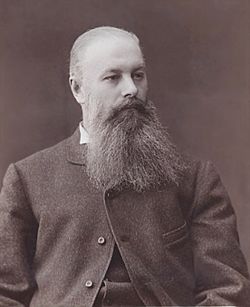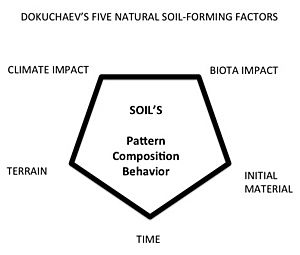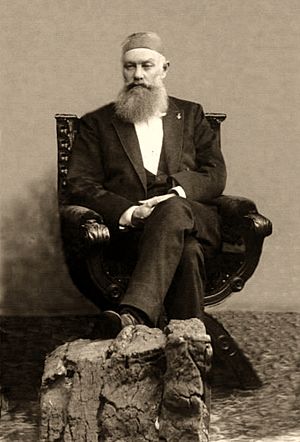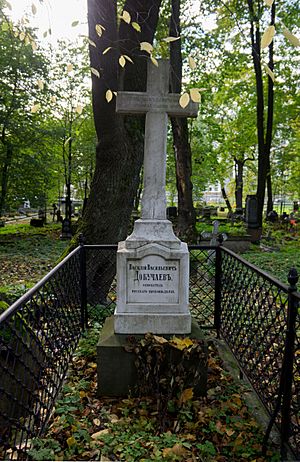Vasily Dokuchaev facts for kids
Quick facts for kids
Vasily V. Dokuchaev
|
|
|---|---|

V. Dokuchaev (Saint Petersburg, 1888)
|
|
| Born | 1 March 1846 Milyukovo, Sychyovsky Uyezd, Smolensk Governorate, Russian Empire
|
| Died | 8 November 1903 (aged 57) Saint Petersburg, Russian Empire
|
| Nationality | Russian |
| Known for | Modern soil science founder |
| Scientific career | |
| Fields | Geography, geology, soil science |
| Institutions | Saint Petersburg University |
| Influenced | Vladimir Vernadsky, Konstantin Glinka, Sergey Kravkov (agronomist), Andrei Krasnov, Vladimir Prokhorovich Amalitskii, Feodor Yulievich Levinson-Lessing, Vladimir Andreevich Tranzschel, Dmitri Ivanovsky, Gavril Tanfilyev, Georgy Fedorovich Morozov |
| Signature | |
 |
|
Vasily Vasilyevich Dokuchaev (Russian: Васи́лий Васи́льевич Докуча́ев; 1 March 1846 – 8 November 1903) was a geologist and geographer who is credited with laying the foundations of soil science. He was from the Russian Empire. The Ukrainian city of Dokuchaievsk is named after him.
Contents
Overview
Vasily Vasilevich Dokuchaev is commonly regarded as the father of soil science, the study of soils in their natural setting. He developed soil science in Russia, and was perhaps the first person to conduct broad geographical investigations of different soil types. His contribution to science did, figuratively, "put soils on the map".
He introduced the idea that the geographical variations in soil type could be explained by other variables besides geological factors (parent material), such as climatic and topographic factors, and by the period of time since the initial pedogenesis (soil formation). Using these ideas as a starting point, he developed the very first soil classification. His ideas were quickly taken up by a number of soil scientists, including Hans Jenny.
Dokuchaev's work on soil science produced a system of soil classification that described five factors for soil formation. He arrived at his theory after extensive field studies on Russian soils in 1883. His most famous work is Russian Chernozem (1883). As a result of Dokuchaev's research, a number of Russian terms became part of the international soil science vocabulary (for example, chernozem, podsol, gley, solonets).
A crater on Mars is named after him, and the Dokuchaev Award, an equivalent of the Nobel Prize in the field of Soil Science, was instituted by the International Union of Soil Sciences in his honor.
Quote
- The scientific basis of soil science as a natural science was established by the classical works of Dokuchaev. Previously, soil had been considered a product of physicochemical transformations of rocks, a dead substrate from which plants derive nutritious mineral elements. Soil and bedrock were in fact equated.
- Dokuchaev considers the soil as a natural body having its own genesis and its own history of development, a body with complex and multiform processes taking place within it. The soil is considered as different from bedrock. The latter becomes soil under the influence of a series of soil-formation factors (climate, vegetation, parent material, relief and age). According to him, soil should be called the "daily" or outward horizons of rocks regardless of the type; they are changed naturally by the common effect of water, air and various kinds of living and dead organisms.
Authored works
Dokuchaev published in 1869-1901: 285 works, including 61 books and 4 maps.
- List of publications (other than in Russian language)
- Dokoutchaief B. 1879. Tchernozème (terre noire) de la Russie d'Europe. St.-Ptb.: Soc. imp. libre économ. 66 p. (C.R. Soc. imp. libre économ. T. 4).
- Inostrantzev A., Schmidt Th., Moeller V., Karpinsky A., Dokoutchaief B. et al. 1882. Rapport de la Sous-commission russe sur l’uniformité de la nomenclature géologique // Congrès géologique international. 2-me session. Bologne. 1881: Compte rendu. Bologne: Fava et Garagnani. P. 529–534.
- Dokoutchaief B. B. 1892. Les steppes russes autrefois et aujurd’hui // Congrès international d'archéologie, préhistorique et d'antropologie. 11 ses. Moscou. 1892. T. 1. Мoscou: impr. universite, T. 1. P. 197–240; Our Steppes Before and Nowadays. St.-Ptb.: Dept. Agriculture Ministry of Crown Domains for the World's Columbian Exposition at Chicago, 1893. 62 p.
- Dokoutchaief B. B. 1892. Notes sur l’étude scientifique du sol en Russie au point de vue de l’agronomie et de la cartographie agricole // Bull. Soc. Belge géol., paleontol., hydrol. 1891/1892. Vol. 4. P. 113–115.
- Dokouchaev V. V. 1893. Notes sur le loess // Bull. Soc. Belge géol., paleontol., hydrol. 1892/1893. Vol. 6. P. 92-101.
- Dokouchaev V. V. Sibirtzev N. M. 1893. Short scientific review of professor Dockuchaev's and his pupil's collection of soils, exhibited in Chicago in the year 1893. St.-Ptb.: impr. Evdokimov. 40 p.
- Dokoutchaief B. B. 1895. Le Court contenu des Travaux de l’expédition, équipée par Departement forestier sous la direction prof. Dokoutschaeff. St.-Ptb.: impr. Evdokimov. 28 p.
- Docoutschaev V. V. 1897. Collection des sols du professeur Docoutschaev et de ses élèves, exposée au Musée minéralogique de l’Université de St-Petersbourg: [7 cong. géol. int.]. St.-Ptb.: impr. Evdokimov 17 p.
- Dokoutschaeff В. B. 1900. Collection pédologique: Zones verticales des sols. Zones agricoles. Sols du Caucase. St.-Ptb.: Ministére des finances. 56 p. : сarte.
- Translations
- Dokuchaev, V. V. Russian Chernozem (1883) // Israel Program for Scientific Translations Ltd. (for USDA-NSF), S. Monson, Jerusalem, 1967. (Translated from Russian into English by N. Kaner).
See also
 In Spanish: Vasili Dokucháyev para niños
In Spanish: Vasili Dokucháyev para niños
- Aleksandr Dokuchayev
- History of soil science
- List of Russian Earth scientists
- List of prizes known as the Nobel of a field





